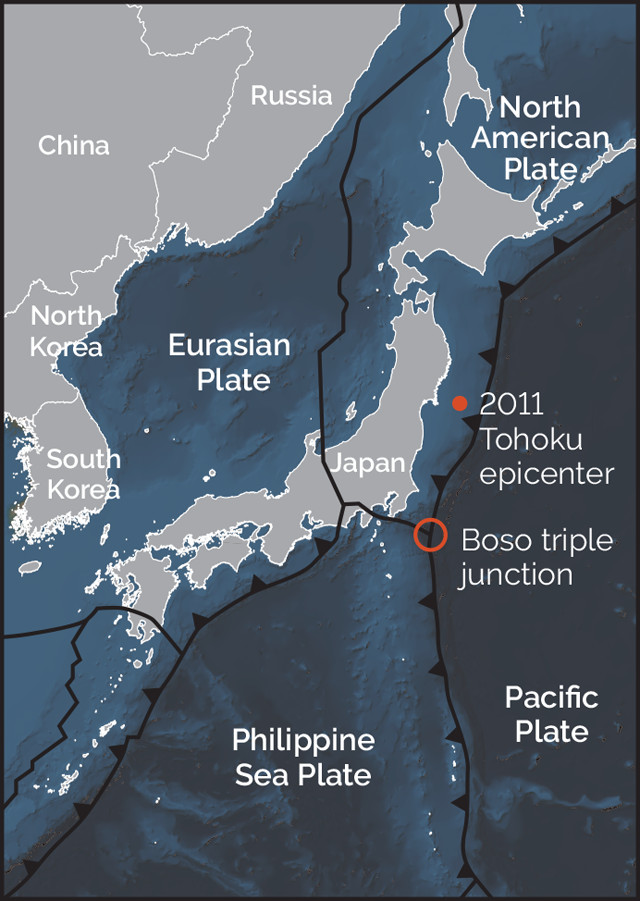
by Mary Caperton Morton Friday, August 3, 2018

The tectonic setting of the 2011 Tohoku quake. Credit: K. Cantner, AGI.
A new analysis of satellite data has revealed a distinct change in the gravity signal measured across the Japanese archipelago starting several months before the March 11, 2011, magnitude-9.1 Tohoku-Oki earthquake — one of the largest seismic events in recorded history. The gravity change reflects interactions among shifting tectonic plates in the region, and its timing shortly before the earthquake raises the tantalizing notion that such signals could portend impending seismicity elsewhere. But researchers say it’s unclear if the signal seen in the new study is unique to the Tohoku quake or if it represents a phenomenon common to other large subduction zone quakes.
A team led by Isabelle Panet, a geophysicist at Paris Diderot University in France, studied regional deformation surrounding the subduction zone offshore Japan. They analyzed satellite data recorded by the twin satellites of the Gravity Recovery and Climate Experiment (GRACE), which launched in 2002 to track anomalies in Earth’s gravity field. These anomalies reflect changes in the distribution of mass around the planet over time, particularly changes in water mass generated by rising sea levels, melting ice sheets, and seasonal filling and emptying of aquifers. Large earthquakes can also affect Earth’s gravity field when large regions of the crust shift. Such changes have been detected previously after major earthquakes — including Tohoku — but the new study, published in Nature Geoscience, reports a change in the gravity field that occurred three months prior to the Tohoku event.
“Our analysis revealed large-scale gravity and mass changes throughout three tectonic plates and connected slabs, starting three months before March 2011,” Panet says. These changes began in late 2010 on both sides of the Boso triple junction, where the North American, Pacific and Philippine Sea plates meet to the east of Japan. And by March 2011, the gravity anomaly had spread along the subduction boundaries of the three tectonic plates.
In a subduction zone, as the subducting slab is forced deeper into the mantle, changing gravity signals are produced by the shifting of mass within and between the plates. This shifting creates stress in the system that propagates upward toward the surface, potentially triggering an earthquake, says Barbara Romanowicz, a planetary seismologist at the University of California, Berkeley, who was not involved in the new study. “The Panet study shows that gravity anomalies can be used to connect the motions that occur deep in the mantle over geological timescales to the surface expressions that occur on human timescales, such as earthquakes,” Romanowicz says. “This technique is fascinating from a basic science point of view as it can help us understand the whole subduction zone system.”
Since the gravity changes occurred months ahead of the earthquake, it’s tempting to wonder if such signals could be used as part of an earthquake early warning system, but that idea is probably “far-fetched,” Romanowicz says. “Right now, we don’t know if this is a unique circumstance that occurred this one time only in this one place, or if there is a shift of masses months before every subduction zone earthquake,” she says.
“There is also the question of timescale. The window [between signal detection and an earthquake] could be anywhere from days to months to millennia,” Romanowicz says. The extreme size of the Tohoku quake may also be a hard-to-meet prerequisite. “It may be possible that you need a magnitude-9 quake to be able to detect this kind of signal.” It’s more likely that a precursory gravity signal could be used to determine where to deploy more instruments and boost monitoring networks over a target region.
Panet agrees that “we cannot talk about prediction based on the analysis of only one event.” She and her colleagues plan to investigate whether they can detect precursory gravity signals before other major subduction zone quakes, such as the 2004 Sumatran or the 2011 Chilean megathrust earthquakes. The GRACE satellites should offer data for most regions of the planet for earthquakes that occurred between March 2002 and October 2017, when the satellites were in operation. “GRACE satellite data have a nearly global coverage, so we expect that we can apply our technique to the GRACE gravity fields at other subduction zones as well,” Panet says.
More modeling is needed to characterize the relationship between mass transfers and associated stress changes, and how these changes lead to earthquakes off Japan and elsewhere, Panet says. But, she notes, “this approach … has allowed us to put the local, extreme seismic event into the broader context of mass redistribution across the whole region.”
© 2008-2021. All rights reserved. Any copying, redistribution or retransmission of any of the contents of this service without the expressed written permission of the American Geosciences Institute is expressly prohibited. Click here for all copyright requests.